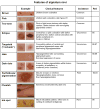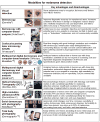Strategies for early melanoma detection: Approaches to the patient with nevi
- PMID: 19389517
- PMCID: PMC2690513
- DOI: 10.1016/j.jaad.2008.10.065
Strategies for early melanoma detection: Approaches to the patient with nevi
Abstract
Given its propensity to metastasize and the lack of effective therapies for most patients with advanced disease, early detection of melanoma is a clinical imperative. Although there are no noninvasive techniques for the definitive diagnosis of melanoma, and the "gold standard" remains biopsy with histologic examination, a variety of modalities may facilitate early melanoma diagnosis and the detection of new and changing nevi. This article reviews the general clinical principles of early melanoma detection and various modalities that are currently available or on the horizon, providing the clinician with an up to date understanding of management strategies for their patients with numerous or atypical nevi.
Learning objective: After completing this learning activity, participants should understand the clinical importance of early melanoma detection, appreciate the challenges of early melanoma diagnosis and which patients are at highest risk, know the general principles of early melanoma detection, be familiar with current and emerging modalities that may facilitate early melanoma diagnosis and the detection of new and changing nevi, know the advantages and limitations of each modality, and be able to practice a combined approach to the patient with numerous or clinically atypical nevi.
Conflict of interest statement
Conflicts of interest: None declared.
Figures





References
-
- Dennis LK. Analysis of the melanoma epidemic, both apparent and real: data from the 1973 through 1994 surveillance, epidemiology, and end results program registry. Arch Dermatol. 1999;135:275–80. - PubMed
-
- Geller AC, Swetter SM, Brooks K, Demierre MF, Yaroch AL. Screening, early detection, and trends for melanoma: current status (2000–2006) and future directions. J Am Acad Dermatol. 2007;57:555–72. - PubMed
-
- Tsao H, Atkins MB, Sober AJ. Management of cutaneous melanoma. N Engl J Med. 2004;351:998–1012. - PubMed
-
- Tsao H, Rogers GS, Sober AJ. An estimate of the annual direct cost of treating cutaneous melanoma. J Am Acad Dermatol. 1998;38:669–80. - PubMed
-
- Tripp JM, Kopf AW, Marghoob AA, Bart RS. Management of dysplastic nevi: a survey of fellows of the American Academy of Dermatology. J Am Acad Dermatol. 2002;46:674–82. - PubMed
Publication types
MeSH terms
Grants and funding
LinkOut - more resources
Full Text Sources
Other Literature Sources
Medical

